The concept of chakras is an integral part of ancient Indian spiritual traditions and has gained widespread recognition in the modern wellness and yoga communities. Chakras are energy centers within the body, each associated with specific physical, emotional, and spiritual functions. There are seven primary chakras, starting from the base of the spine to the crown of the head, each governing different aspects of our being. By practicing specific yoga asanas (poses), you can stimulate, balance, and activate these chakras, promoting overall well-being.
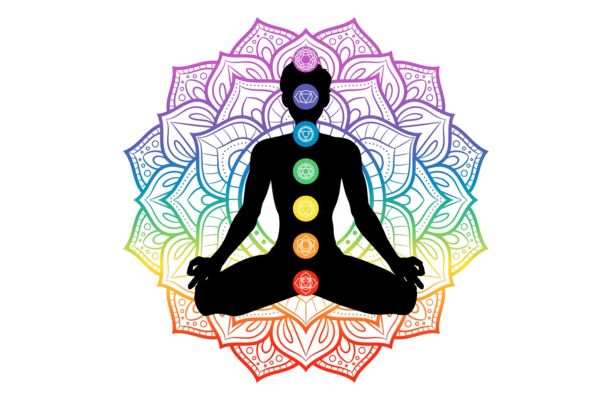
1. Muladhara (Root Chakra) – Mountain Pose (Tadasana)
Location: Base of the spine
Color: Red
Element: Earth
Associated Aspects: Survival, grounding, stability
The Root Chakra is the foundation of the chakra system, grounding you in the physical world. When balanced, it brings a sense of security and stability. Mountain Pose is an excellent way to activate the Root Chakra.
How to Perform Tadasana:
- Stand with your feet together, big toes touching, and heels slightly apart.
- Distribute your weight evenly across both feet.
- Engage your thigh muscles, lift your kneecaps, and keep your legs strong.
- Lengthen your spine, roll your shoulders back and down, and let your arms hang beside your torso with palms facing forward.
- Ground down through your feet, feeling the connection with the earth.
Benefits: Tadasana helps in grounding, improves posture, and instills a sense of balance and stability, aligning with the Root Chakra’s energy.
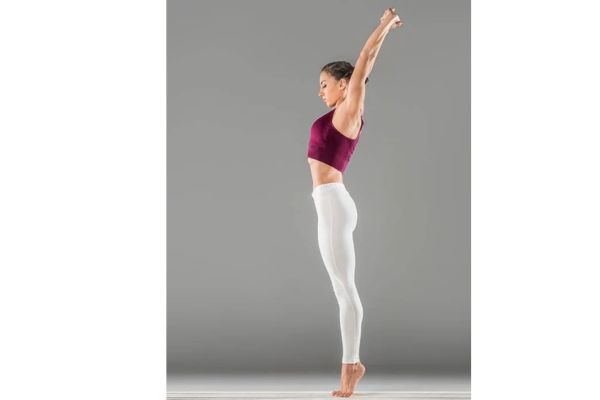
2. Svadhisthana (Sacral Chakra) – Goddess Pose (Utkata Konasana)
Location: Lower abdomen, about two inches below the navel
Color: Orange
Element: Water
Associated Aspects: Creativity, sexuality, pleasure
The Sacral Chakra is associated with emotions, creativity, and sensuality. A balanced Sacral Chakra allows for the free flow of emotions and creative expression. Goddess Pose is effective in stimulating this energy center.
How to Perform Utkata Konasana:
- Stand with your feet wide apart, turning your toes out to a 45-degree angle.
- Bend your knees deeply, aligning them over your ankles, and lower your hips into a squat.
- Ensure your torso is upright and your spine is elongated.
- Raise your arms to shoulder height, bend your elbows, and point your fingertips towards the ceiling with palms facing inward.
- Engage your core and feel the stretch in your inner thighs and hips.
Benefits: Goddess Pose opens up the hips, stimulates the lower abdomen, and enhances creativity and emotional balance, resonating with the Sacral Chakra.

3. Manipura (Solar Plexus Chakra) – Boat Pose (Navasana)
Location: Upper abdomen, above the navel
Color: Yellow
Element: Fire
Associated Aspects: Personal power, confidence, self-esteem
The Solar Plexus Chakra is the center of personal power, confidence, and self-esteem. When this chakra is balanced, you feel in control and confident. Boat Pose is ideal for activating the Solar Plexus Chakra.
How to Perform Navasana:
- Sit on the floor with your legs extended in front of you.
- Lean back slightly while keeping your spine straight and lift your legs off the floor, balancing on your sit bones.
- Bend your knees if necessary, or straighten them for a more intense pose.
- Extend your arms forward, parallel to the floor, with palms facing inward.
- Engage your core and hold the pose, keeping your back straight.
Benefits: Boat Pose strengthens the core, enhances concentration, and boosts confidence and self-esteem, aligning with the Solar Plexus Chakra’s energy.
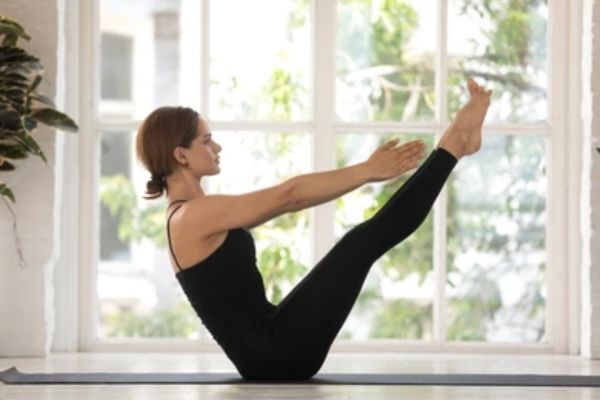
4. Anahata (Heart Chakra) – Camel Pose (Ustrasana)
Location: Center of the chest
Color: Green
Element: Air
Associated Aspects: Love, compassion, forgiveness
The Heart Chakra is the center of love, compassion, and forgiveness. A balanced Heart Chakra allows you to give and receive love freely. Camel Pose is effective in opening the Heart Chakra.
How to Perform Ustrasana:
- Kneel on the floor with your knees hip-width apart and thighs perpendicular to the floor.
- Place your hands on the back of your pelvis, fingers pointing down.
- Press your tailbone forward, lean back, and reach for your heels with your hands.
- Lift your chest towards the ceiling, allowing your head to drop back gently.
- Keep your thighs perpendicular to the floor and engage your core.
Benefits: Camel Pose opens the chest, stretches the front of the body, and fosters emotional openness and compassion, resonating with the Heart Chakra.
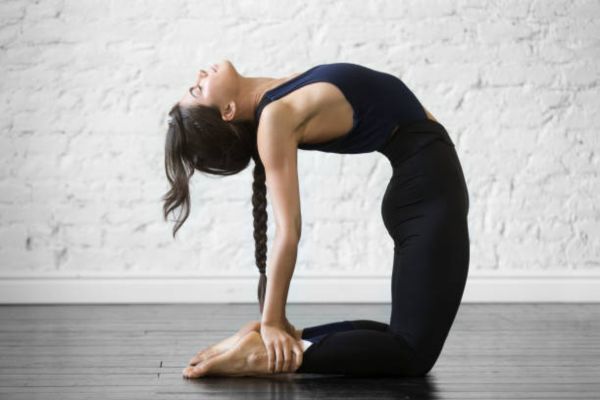
5. Vishuddha (Throat Chakra) – Shoulder Stand (Sarvangasana)
Location: Throat
Color: Blue
Element: Ether
Associated Aspects: Communication, expression, truth
The Throat Chakra is the center of communication and self-expression. When balanced, it allows you to express yourself clearly and truthfully. Shoulder Stand is a powerful pose to activate the Throat Chakra.
How to Perform Sarvangasana:
- Lie on your back with your arms beside your body.
- Lift your legs and hips off the floor, bringing your legs over your head into Plow Pose (Halasana).
- Support your lower back with your hands and lift your legs towards the ceiling.
- Keep your body straight and your chin tucked into your chest.
- Hold the pose and breathe deeply.
Benefits: Shoulder Stand stimulates the throat, thyroid gland, and enhances communication and self-expression, aligning with the Throat Chakra’s energy.
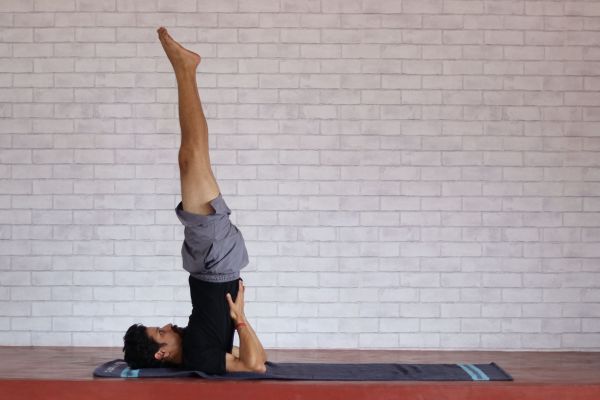
6. Ajna (Third Eye Chakra) – Child’s Pose (Balasana)
Location: Between the eyebrows
Color: Indigo
Element: Light
Associated Aspects: Intuition, insight, wisdom
The Third Eye Chakra is associated with intuition, insight, and wisdom. A balanced Third Eye Chakra enhances your intuitive abilities and inner vision. Child’s Pose is a gentle way to activate the Third Eye Chakra.
How to Perform Balasana:
- Kneel on the floor with your big toes touching and knees wide apart.
- Sit back on your heels and extend your arms forward, lowering your forehead to the floor.
- Relax your arms alongside your body or stretch them in front of you.
- Focus on your breath and the point between your eyebrows.
Benefits: Child’s Pose calms the mind, enhances intuition, and promotes a sense of inner peace, resonating with the Third Eye Chakra.
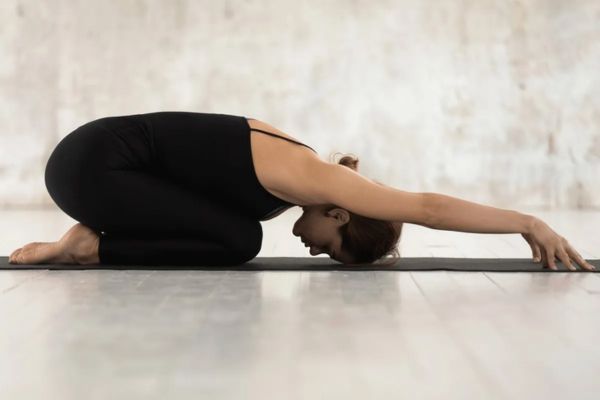
7. Sahasrara (Crown Chakra) – Headstand (Sirsasana)
Location: Top of the head
Color: Violet or White
Element: Thought
Associated Aspects: Spirituality, enlightenment, connection to the divine
The Crown Chakra is the highest chakra, representing spiritual connection and enlightenment. When balanced, it fosters a deep connection with the divine and a sense of universal consciousness. Headstand is an effective pose to activate the Crown Chakra.
How to Perform Sirsasana:
- Kneel on the floor and interlace your fingers, placing your forearms on the ground.
- Place the crown of your head on the floor, cupped by your interlaced fingers.
- Lift your knees off the floor and walk your feet towards your head.
- Engage your core and lift your legs towards the ceiling, coming into a straight line.
- Hold the pose, focusing on balance and breath.
Benefits: Headstand stimulates the crown of the head, enhances spiritual awareness, and promotes a sense of connection to the divine, aligning with the Crown Chakra’s energy.
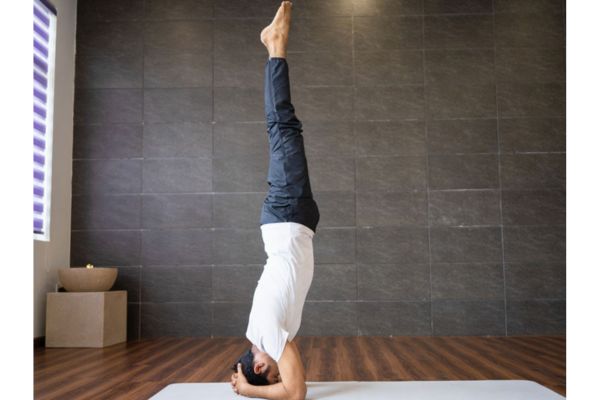
Additional Tips for Chakra Balancing
In addition to yoga asanas, there are several other practices that can help activate and balance your chakras:
- Pranayama (Breath Control): Specific breathing techniques can enhance the flow of energy through the chakras. For example, alternate nostril breathing (Nadi Shodhana) is particularly effective in balancing the energy channels.
- Mantras and Chanting: Each chakra has a corresponding bija mantra (seed sound). Chanting these mantras can help activate and balance the chakras. For example, the Root Chakra mantra is “Lam,” the Sacral Chakra is “Vam,” and so on.
- Crystals and Gemstones: Certain crystals and gemstones are believed to resonate with the energy of specific chakras. For example, red jasper for the Root Chakra, carnelian for the Sacral Chakra, and amethyst for the Crown Chakra. Carrying or meditating with these stones can support chakra balancing.
- Aromatherapy: Essential oils can also influence the chakras. Using oils like sandalwood for the Root Chakra, ylang-ylang for the Sacral Chakra, and frankincense for the Crown Chakra can enhance your practice.
- Diet and Nutrition: Eating foods that correspond to the colors of the chakras can support their energy. For example, red foods like tomatoes and beets for the Root Chakra, orange foods like carrots and oranges for the Sacral Chakra, and so on.
The Benefits of Chakra Balancing
When the chakras are balanced and activated, the benefits extend to all areas of your life:
- Physical Health: Balanced chakras contribute to overall physical health, improving energy levels, digestion, immunity, and more.
- Emotional Well-being: Chakra balancing can lead to emotional stability, reducing stress, anxiety, and depression. It fosters a sense of inner peace and emotional resilience.
- Mental Clarity: Activating the chakras enhances mental clarity, focus, and creativity. It promotes clear thinking and decision-making.
- Spiritual Growth: A balanced chakra system supports spiritual growth and development. It opens pathways for higher consciousness, intuition, and a deeper connection to the universe.
- Improved Relationships: By balancing your chakras, you improve your ability to communicate, empathize, and connect with others, fostering healthier and more fulfilling relationships.
Conclusion
Chakra balancing through yoga asanas is a powerful practice that can transform your physical, emotional, mental, and spiritual well-being. By incorporating specific poses to activate each chakra, you can create harmony within your energy system, leading to a more balanced and fulfilling life. Remember to practice with intention, mindfulness, and respect for your body’s needs. As you continue to explore and deepen your understanding of the chakras, you will unlock new levels of awareness and vitality.
Incorporating these seven yoga asanas into your regular practice can be a beautiful journey of self-discovery and healing. Each pose serves as a gateway to understanding and nurturing the different aspects of your being, from the grounding stability of the Root Chakra to the divine connection of the Crown Chakra. Embrace the journey, honor your body, and allow the wisdom of the chakras to guide you towards a state of balance and harmony.
